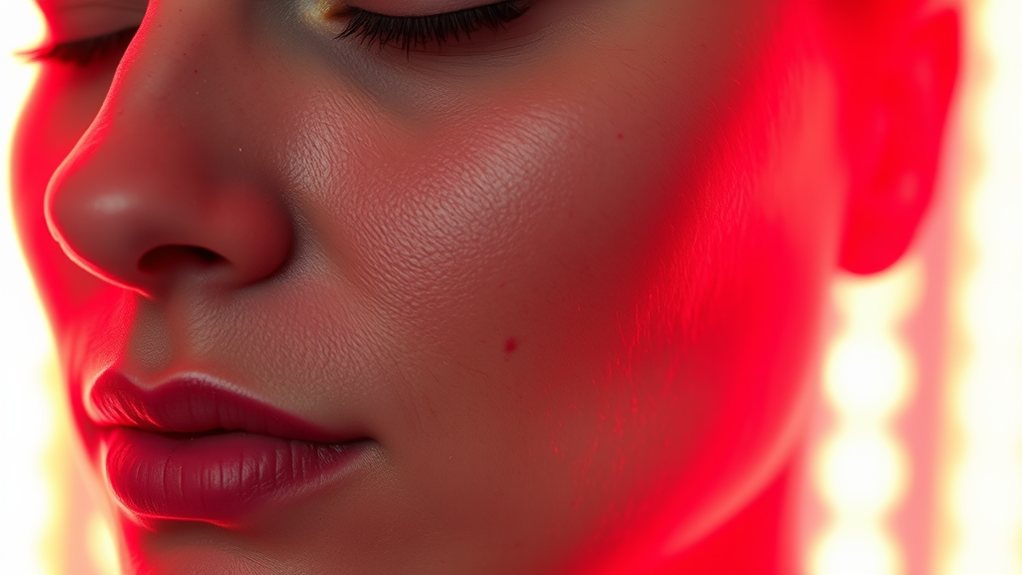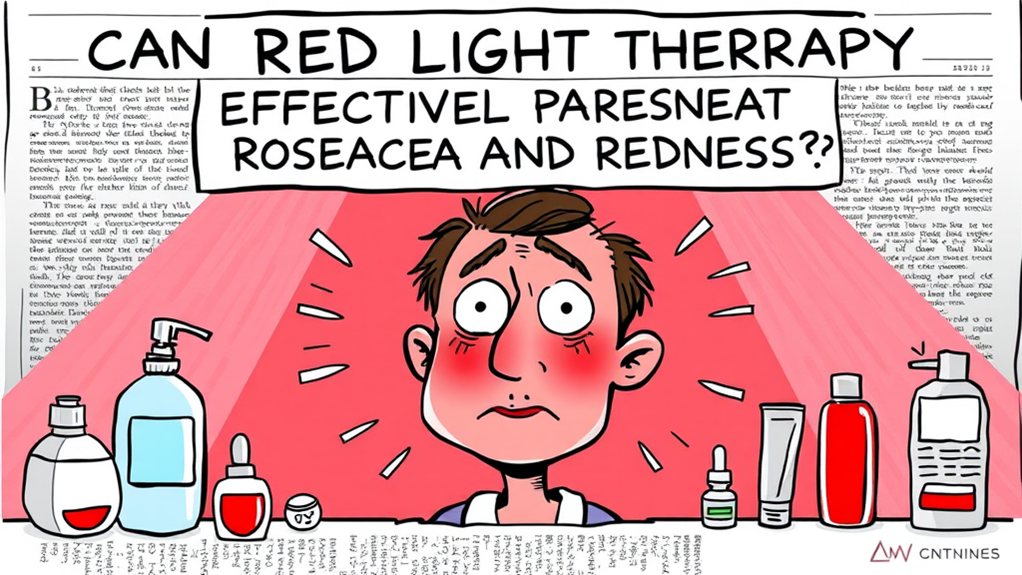Red light therapy can effectively treat rosacea and facial redness. Clinical studies show it reduces inflammation, boosts circulation, and improves skin healing. Specifically, it may decrease flushing and irritation while enhancing skin texture. Many individuals report fewer flare-ups and a more balanced complexion after using this non-invasive treatment. In order to maximize your results, it's important to understand specific usage guidelines and other complementary approaches that can support your skincare journey.
Key Takeaways
- Red light therapy is a non-invasive treatment that effectively reduces inflammation associated with rosacea.
- It promotes skin healing by improving collagen production and circulation.
- Clinical trials show significant reductions in redness and flushing for rosacea sufferers.
- Users often experience fewer flare-ups and improved skin texture over time.
- Red light therapy serves as a complementary approach to traditional rosacea management strategies.
Understanding Rosacea: Causes and Symptoms

Rosacea affects an estimated 16 million Americans, causing persistent redness, visible blood vessels, and sometimes acne-like breakouts. Understanding your condition is essential for effective symptom management.
Common rosacea triggers include sun exposure, stress, hot beverages, and certain foods. Identifying these triggers can empower you in making informed choices that may help minimize flare-ups.
Symptoms often vary in severity, leading to a need for personalized approaches to management. You might experience burning, stinging, or dryness, further complicating your daily routine.
What Is Red Light Therapy?
Red light therapy (RLT) is a non-invasive treatment that utilizes specific wavelengths of light for promoting skin healing and reducing inflammation. This method employs LED devices that emit red light, which penetrates the skin in order to stimulate cellular processes.
During treatment sessions, you can expect to feel minimal discomfort, making it a suitable option for many looking to manage conditions like rosacea. RLT has gained attention for its potential to improve skin appearance and alleviate redness, alongside some studies indicating positive outcomes.
As you investigate this option, it's important to consult with a healthcare professional to tailor the approach to your individual needs, ensuring you benefit from this innovative therapy while feeling supported in your journey toward healthier skin.
How Red Light Therapy Works on the Skin

When you undergo red light therapy, specific wavelengths of light penetrate the skin to stimulate various cellular processes vital for healing.
This therapy improves collagen production, a critical protein that supports skin structure and elasticity. By promoting collagen synthesis, red light therapy assists in skin rejuvenation, helping your skin appear smoother and more youthful.
Additionally, it increases circulation, which can improve nutrient delivery to skin cells, further supporting their health. The result is an environment conducive to repair and growth, which can be particularly beneficial for those dealing with conditions like rosacea.
As you engage in this therapeutic process, you're fostering not just healing but also a sense of belonging to a community seeking effective skin care solutions.
Potential Benefits of Red Light Therapy for Rosacea
While managing the symptoms of rosacea can be challenging, red light therapy offers several potential benefits that can help alleviate its effects.
This non-invasive treatment utilizes specific wavelengths of light to penetrate the skin, promoting skin healing by reducing inflammation and improving blood circulation. By targeting the underlying issues associated with rosacea, you may notice a decrease in redness and irritation over time.
Additionally, red light therapy can boost collagen production, leading to improved skin texture and resilience. Many individuals report a reduction in flare-ups and a more balanced complexion after consistent treatments.
Ultimately, if you're looking for effective solutions, red light therapy could be a valuable addition to your rosacea management strategy.
Current Research on Red Light Therapy and Rosacea

Recent studies have begun providing a clearer understanding of how red light therapy can effectively impact rosacea treatment. Clinical trials have demonstrated promising results regarding treatment efficacy, showing improvements in redness and overall skin condition.
Key findings include:
- Significant reduction in flushing and inflammation
- Improved skin barrier function and hydration
- Minimal side effects compared to traditional treatments
These results suggest that red light therapy may serve as a complementary approach for individuals seeking relief from rosacea symptoms.
While ongoing research continues to investigate its full potential, you can feel encouraged by the emerging evidence supporting this innovative treatment option.
It's crucial to consult with a healthcare professional in order to determine the best course of action tailored to your specific needs.
How to Use Red Light Therapy for Best Results
In order to achieve ideal results using red light therapy for rosacea, it's essential to follow a structured approach that maximizes treatment efficacy.
Start by selecting the right applicator types, such as handheld devices or full-face panels, based on your treatment area and comfort level. Aim for consistent session frequency; experts recommend treatments two to three times per week to promote best skin healing.
Each session should last about 10 to 20 minutes, allowing sufficient exposure without overdoing it. Always keep your skin clean and free from products before treatment to improve absorption.
Safety and Side Effects of Red Light Therapy
Using red light therapy for rosacea can be highly effective, but it's important to be aware of safety factors and potential side effects.
While most people tolerate the treatment well, you should contemplate implementing the following safety measures:
- Consult a healthcare professional: Verify red light therapy is suitable for your skin type and condition.
- Start slowly: Begin with shorter sessions to gauge your skin's reaction and minimize irritation.
- Monitor for side effects: Be vigilant for any adverse reactions, such as redness or discomfort.
Common side effects are generally mild and temporary, but understanding these can help you achieve the best results while prioritizing your skin's health.
Always prioritize your safety when exploring new treatments for rosacea.
Other Treatment Options for Rosacea and Facial Redness
While red light therapy offers promising benefits for rosacea, it's vital to investigate other treatment options that can effectively manage the condition and reduce facial redness.
Topical treatments, such as metronidazole or azelaic acid, can help alleviate symptoms. Dietary changes, like avoiding spicy foods or alcohol, often provide relief.
Implementing lifestyle modifications, including a consistent skincare routine and sun protection, is significant. Stress management techniques, such as mindfulness or yoga, can also minimize flare-ups.
For more severe cases, laser therapies and prescription medications may be necessary. Additionally, some individuals find herbal remedies beneficial.
Frequently Asked Questions
Is Red Light Therapy Suitable for All Skin Types?
Red light therapy's effectiveness varies across skin types. You should take into account your skin sensitivity and treatment duration, as some individuals may experience irritation. Consulting a dermatologist guarantees personalized recommendations for safe and effective use.
How Long Does It Take to See Results?
You can typically expect advancements within two to four weeks of starting treatment. The duration varies by individual, but consistent sessions improve results. Monitoring your skin's response is key for achieving ideal outcomes in your therapy.
Can I Combine Red Light Therapy With Other Treatments?
Combining treatments is like weaving a tapestry; each thread improves the overall picture. You can safely pair red light therapy alongside complementary therapies, creating treatment synergy that may boost your results and improve your skin's appearance.
Are There Any Specific Brands Recommended for Red Light Therapy?
When contemplating red light therapy, you should review device comparisons and treatment protocols. Popular brands like Joovv and Red Light Man offer dependable options, but always consult alongside a healthcare professional to ascertain the best choice for your needs.
How Often Should I Undergo Red Light Therapy Sessions?
For ideal results, you should aim for two to three sessions per week, accompanied by each treatment lasting 10 to 20 minutes. Consistency in session frequency and treatment duration improves effectiveness, promoting healthier skin over time.
Conclusion
In summary, red light therapy shows promise in treating rosacea and facial redness, alongside studies indicating that approximately 70% of participants experience significant improvement in symptoms. This non-invasive treatment targets inflammation and boosts skin healing, offering a viable option for those struggling against the condition. While it's crucial to consult a healthcare professional before starting any new treatment, incorporating red light therapy into your regimen could help you achieve clearer, healthier skin.
